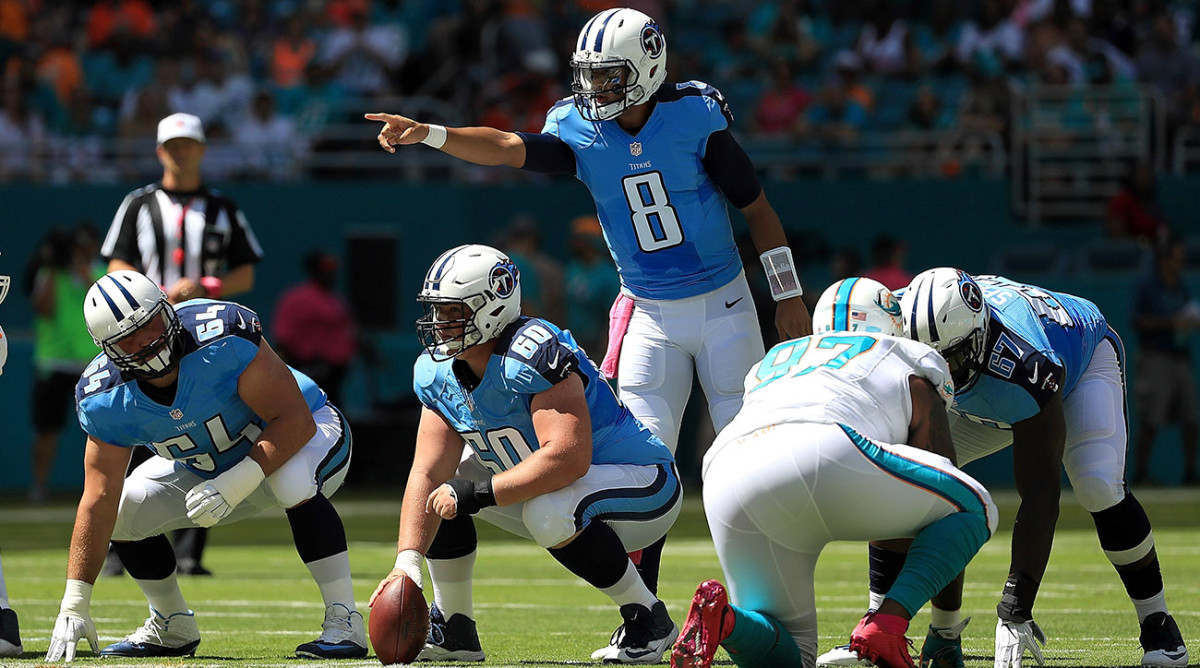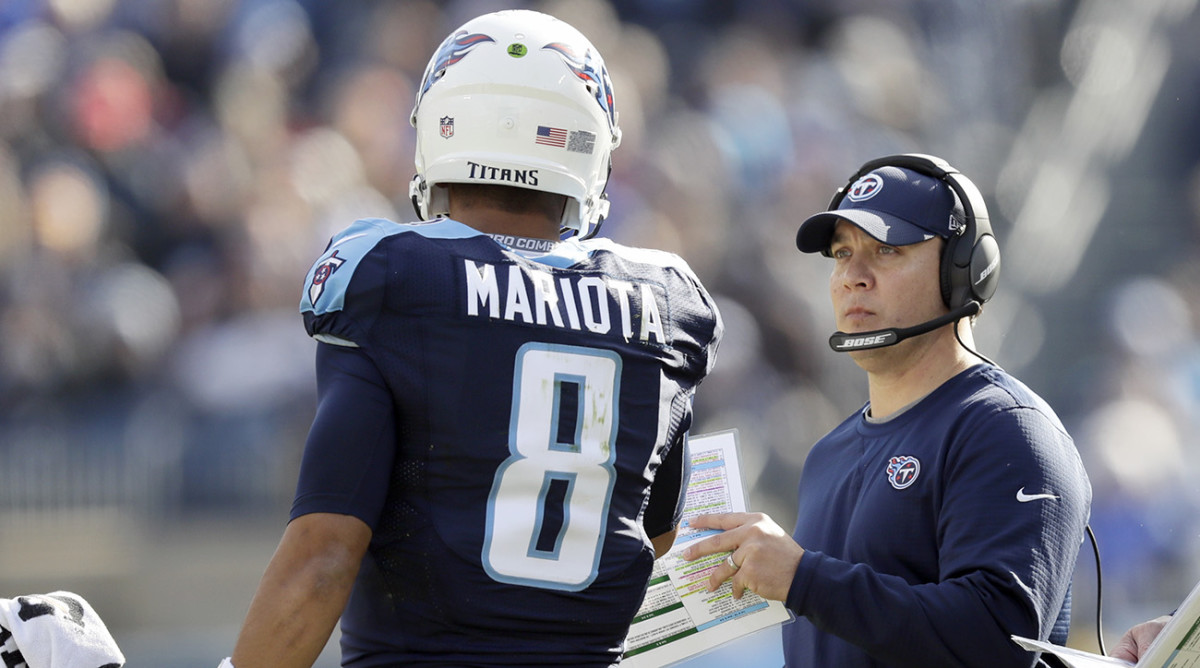The Education of Marcus Mariota

NASHVILLE, Tenn. — In the months leading up to the 2015 draft, the Tennessee Titans, owners of the No. 2 overall pick, did their due diligence on both of the top quarterbacks available: Jameis Winston and Marcus Mariota. Winston was the traditional pocket passer, while Mariota was the electric dual-threat quarterback who’d played in Chip Kelly’s spread-option offense at Oregon. Pundits wondered how Mariota would transition to the pros—a question that has dogged spread quarterbacks going back to the dawning of the offense.
For Oregon’s Pro Day, the Titans sent a large contingent, all of the major decision-makers in the organization—general manager Ruston Webster, head coach Ken Whisenhunt, offensive coordinator Jason Michael and quarterbacks coach John McNulty among them. They watched Mariota go through his throwing drills, then they kept him after for a private workout, and then they all went upstairs to a room in the team facility to watch film.
That session focused mostly on Mariota’s Oregon tape. They pulled up specific clips, games in which Mariota faced some adversity. Maybe he was under duress against a blitz-happy defense, or maybe the Ducks were in a close game and he had to throw more in the second half. They’d ask, “How’d you set up your protection here?” And then: “What were you seeing on that throw?” They wanted to see how he processed the game, how he came to make decisions, how his mind worked.
Then at times, Michael, the offensive coordinator, would stop the film and discuss verbiage of the play call they were seeing unfold. The Ducks’ used a lot of no-huddle, hurry-up, where the play call is often a simple word or phrase. Whisenhunt and the Titans used a traditional pro-style offense, where some play calls sounded as long as a fast-food order. The basic concepts were mostly the same, just named differently. If Oregon named a certain blocking scheme, say, “Twins,” the Titans might call it “Trout.” Michael would point out the differences to Mariota as they went.
A few weeks later, the Titans brought Mariota to Tennessee. They had him throw again and then staged another film session, but this time they focused more on Titans film and they discussed how Mariota could fit in their offense. Michael sent Mariota to the white board and quizzed him on the concepts he had taught him at their prior meeting, seeing if he remembered what the Titans called them.
Now draw up Trout. Explain it to me. How would we block it?
What about this route combination? Draw it. Take me through your progression.
When the draft finally arrived, the Bucs took Winston No. 1 overall and the Titans were thrilled to take Mariota. After all of their pre-draft prodding, they were confident that Mariota had the football IQ to pick up a pro-style offense.
It was up to Michael, then, to oversee the transition. Through two seasons, Mariota has thrown for more than 6,000 yards and, last season, took the Titans, a two-win team the season before he arrived, to within a game of the playoffs. Entering his third season, the quarterback is on the verge of stardom. This is due, in part, to the plan that Michael and the Titans staff put in place to develop their franchise QB, a plan that has worked so well it could serve as a blueprint for all spread quarterbacks making the transition to the NFL.

Michael was better prepared to teach Mariota than most coaches. He played quarterback at Western Kentucky under Jack Harbaugh—father of John and Jim—back when the Jack ran the triple-option. They’d have three running backs in the backfield, and he’d be the pitch man. “I understood what Marcus was looking at [at Oregon], what he was doing,” Michael says. Then Michael had spent about 12 years working his way up the coaching ladder, coaching under Phillip Fulmer at the University of Tennessee, Jim Harbaugh with the 49ers, and Norv Turner at two separate stops. Michael had seen a variety of offensive styles and concepts.
He bristles when players are labeled as “spread quarterbacks.” “Football is football. I mean, it’s just a matter of how things tie together. Pro-style, spread system—there are so many [similar] concepts in both. I think they just get tagged certain ways. Yeah, there are certain things [Mariota] did at Oregon that he’s not going to do here. But there’s a lot of things that he did there that he continued to do here. There’s a lot of carryover.”
For one, running the spread at Oregon, in which he was often a runner by design, actually taught Mariota how to read the front-seven properly. “That’s typically the last thing [quarterbacks] learn,” Michael says. “He had a great grasp of it.” And that, in turn, helped Mariota learn coverage schemes. “A lot of times the coverage is going to tie into the front,” Michael says. “If it’s a certain pressure, the coverage is going to go [a certain way].”
Some of the passing concepts carried over, too. When Mariota threw at Oregon, Michael saw him go through a progression. “He read it left-to-right across the field,” Michael says. “One, two, three, four—from left to right . . . There’s a number of those plays here. You’re reading X—is X open? No. Is Z open? No. Is F open? Is H open?”
Tennessee Titans: 10 Things You Need to Know
The hardest part for Mariota as a rookie was simply calling plays in the huddle. At Oregon, coaches often had a symbol, a picture, or a short phrase that signified an entire play. Michael reads off one of the Titans’ plays: “Two near, wide 40, X fly … post 31, crush fat, Y bang.” That’s one play. Each of those words, letters and numbers signify the formation, the protection, the routes, the run—they give out assignments to the other 10 players on the field. Michael looks up smiling. “Some calls are longer than others.”
That first year, Michael constantly tested Mariota on the playbook. During practice, during special teams drills, Michael would take Mariota aside and read a play call off to him, as if he were in Mariota’s helmet microphone. Then Mariota had to recite it back to him, as if he were saying it to his teammates in the huddle. Later, while they were watching film, Michael would stop the tape and ask Mariota, “What’s this play called?” That way, “he’s building a picture as he says it in his mind,” Michael says. “Instead of ‘A-B-C,’ he’s seeing it as a picture.”
Once Mariota got the play calls down, he had to master another seemingly simple act: taking a snap from under center. At Oregon, he had worked almost exclusively out of the shotgun. That first year, during offseason workouts and training camp, the Titans ran a majority of their plays from under center, if only to get Mariota more acclimated to it. A large part of Whisenhunt’s offense was predicated on the play-action run game, and operating from under center. The idea was, if you made the play-action look close to a normal handoff, it’d open up the passing game. “It was never really an option.” Michael says. “It was like, ‘Hey, we’re doing this.’”
During individual drills, Mariota practiced taking a snap, dropping back—three steps, five steps, seven steps—and surveying the field. He had to adjust to having different sightlines to his receivers when he was dropping, compared to when he was standing still in shotgun. Michael would watch Mariota’s eyes as he went; he could tell if Mariota was going through his progressions the correct way.
Then Michael would watch Mariota’s mechanics as he released the ball, making sure that he was throwing from the same, balanced position. Mariota sometimes has a habit of throwing off his front foot, which causes his passes to come out at a lower trajectory. That’s in part why Mariota’s statistics dipped at the end of the 2016 season. If he’s under center or in shotgun, if he’s dropping back three steps or seven, Michael says, “You want to be in the same position in the end. You’re just getting to that point in different ways. It’s the subtle movements of staying in balance, getting back to that balance where you’re comfortable throwing.”
Mariota had to get this all down—the play calling, the snap from under center, throwing on his seventh step—or else it would throw off the timing and rhythm of the entire offense. “There’s no doubt when he was at home, he was [practicing his footwork] in his living room,” Michael says.

Midway through Mariota’s rookie year, and despite his solid play, the Titans fired Whisenhunt and promoted Mike Mularkey from tight ends coach to head coach. When Mularkey took over he hired Terry Robiskie, the Falcons’ longtime wide receivers coach, to be offensive coordinator. Mularkey kept Michael on as the quarterbacks coach, in part because of the rapport he had developed with Mariota. The Titans did not want to disrupt their rookie’s progress.
At the time, Mariota and Michael were establishing a game-week preparation routine, one that they still use it today. It starts on Tuesday, which is typically an off day for players. Mariota and the other quarterbacks come to the team facility and spend about 90 minutes with Michael, reviewing the plays they’ll use in the run game, plays they’ll use on first and second downs, and get part of the way through the third-down plays. That gives them a head start on the week ahead, when they’ll also be installing the plays they run when they’re being blitzed, plays they run in the red zone, and plays they run in goal line situations. During the week, once the coaches install those plays, they’ll send them directly to the players’ iPads. Often, Mariota will text Michael with questions, wanting to know why they’re using certain plays against certain opponents. “I understand how he thinks,” Michael says. “The more time you spend around guys, the better you are at explaining [concepts] in a way that they’ll understand. You have something to pull from. ‘Hey, this is the same exact thing the way we ran it against Chicago two years ago.’ ‘Oh, that play.’”
Eclipse 2017: Totality With the Titans
Mariota began running a players-only film session to review those plays with the rest of the offense. He wants to make sure that the receivers know where he wants them to be, and that the linemen know which protections he’s going to call. Mariota will continue these conversations in the locker room, the lunch room, the weight room. “Coaches will be like, ‘Hey, Delanie [Walker], we want you to do this,’” says Robiskie. “And Delanie will be like: ‘No, no, I talked to Marcus and he wants me to do it that way.’ Well, O.K., as long as ya’ll are on the same page.”
Toward the end of the week, Mariota meets with Michael and they review the play sheet. Mariota will have marked the sheet up, ranking the plays he likes on first down, third down, and in the red zone. He crosses some plays out with a red line; those are the plays he’s not comfortable with. Some plays he highlights, which means to hold off on them until they see what the defense is doing. Next to other plays, he puts a check mark; when one of those plays is called, Mariota wants Michael to remind him of his reads.
As the quarterbacks coach, Michael is in Mariota’s headset before every snap. Don’t forget your checkdown here. We’re in field goal range, don’t take a sack here. Run this play away from the three-technique. “You’re just trying to talk him through the game,” Michael says.
Meanwhile, Michael and Mariota are discussing at length the audibles that Mariota will call during the game. Mariota doesn’t have complete freedom to audible into any play in the playbook. Instead, Michael gives him a set of plays he can audible to, depending on how the defense looks pre-snap. If the safety is doing this, audible to that. Automatic.
All of this comes together during Friday’s practice. The Titans go through the plays that Mariota likes and clean them up, going at full speed. This is unusual, because most teams usually use Friday’s practice as a walkthrough. The Titans call them, “Fast Fridays.” Walker credits those Fridays with creating and cementing his bond with his QB. “We just click when those plays come up,” Walker says. “It’s about having a feel. When we have a feel for a route, he can just put it there without even looking.” Maybe that’s why the tight end has been on the receiving end of 30% of Mariota’s passing yards (1,888) and 29% of touchdown throws (13) over two seasons.
Michael thinks Fast Fridays has a bigger impact than that. The Titans also review their red zone, goal line and short-yardage plays on those days, and Michael points to Mariota’s red-zone stats: Last season, he had 18 touchdowns, zero interceptions, and completed 63 percent of his passes, the fifth-highest completion rate among regular starters, behind only Tom Brady, Drew Brees, Ryan Tannehill and Sam Bradford.
Want to know how Mariota has handled the transition from a spread to the pro style? Just watch the tape, Robiskie says. Watch Mariota call plays in the huddle, take a snap from under center, and drop back seven steps with the grace of a ballroom dancer. Watch him read the defense calmly, under pressure, and then fire a strike to Walker. The alternative isn’t bad, either. If the play breaks down—if all of that time, preparation and drilling with Michael goes out the window—“Then you let Marcus be Marcus,” Robiskie says. “He goes out and lets his natural God-given ability take over.”
• Question or comment? Email us at talkback@themmqb.com.
